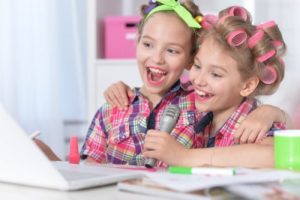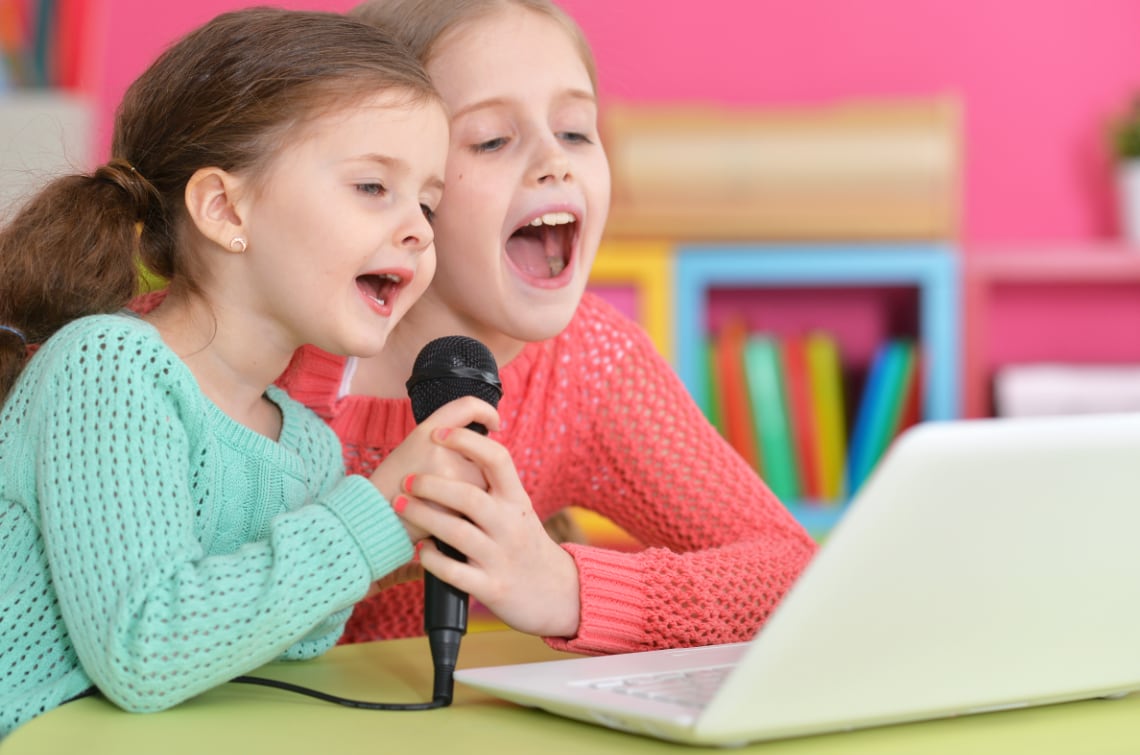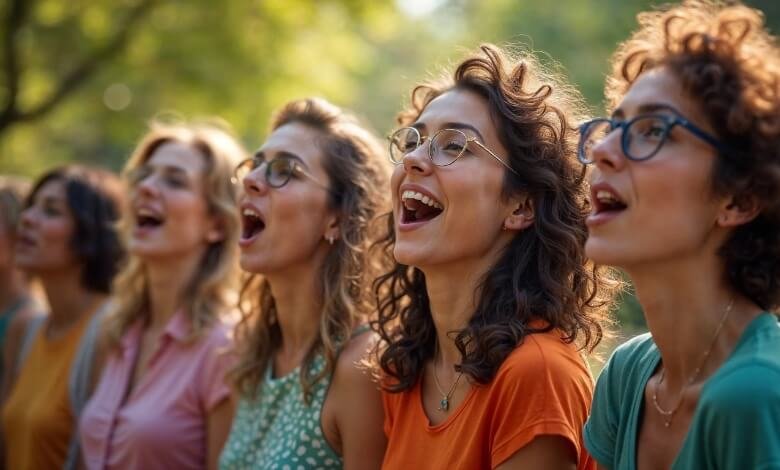Article index
Can karaoke be an educational tool? Let's try to deepen this theme together.
A large garden, a gazebo and the scent of the pizzas made in a wood oven by expert hands, the joy of gathering after the lockdown imposed by Covid-19, the birthday party of an eighty-year-old lady. The evening, which saw me lucky guest, surrounded by the summer mountain air, is enriched by the presence of music.
The sax of an ancient voice - an eighty -year -old musician friend of the family - accompanied by the technology of the bases, offers, with the choice of the repertoire, a historical glimpse of the musical culture of the place over the years and highlights the close link between music and the Significant affective and social experiences of human existence, a musical and cultural identity that manifests itself with all its beauty in the fresh hours of the evening.
 Two girls, respectively 7 and 11 years old, daughters of the hosts, participate in the event asking to be able to sing their favorite songs.
Two girls, respectively 7 and 11 years old, daughters of the hosts, participate in the event asking to be able to sing their favorite songs.
I am amazed to observe how behind that tiny screen with the text, the young girls, they turn into "small" interpreters performing a real musical performance not only of singing in Cicirenella but also of dance. A song in particular- Jerusalema- provides for some dance steps, which, especially the largest, knows well.
With the electro-African flavor of Master Kg in Jerusalema, to the rhythm of Karaoke Guantanamera of the Reggge Band Boomdabash and Alessandra Amoroso, passing through the notes of the popular tradition Cicirinella and the nostalgic taste of the 60s of Jimmy Fontana in my serenade , experience is done of different sounds and rhythms by gender, styles, eras and cultures.
This summer experience has evoked my mind a research work encountered during my study path, on technolgia and in particular on the use of karaoke in singing and in the teaching of music by opening up to many questions about my practice as a music teacher at school .
Kasha and her karaoke
The researcher Susan Young tells of Kasha (Young, 2007), a six -year -old girl and her singing experience that is realized thanks to the karaoke that she was given for Christmas.
Kasha sings the songs of the artists in her room, choosing the ones I like most. Young highlights how the nature of this experience is supported and made thanks to technology and as Kasha in his family context has transformed an exclusive space of his room into a space for personal entertainment activities, a space that does not coincide with areas already used by the family as common areas.
Karaoke can be missed within the didactic areas; It is often relegated by means of entertainment in contexts other than school ones.
Can we use karaoke in music teaching? In singing lessons? Which repertoire do we choose for our little students? How close is this repertoire or take into account the musical experience that children make the school walls out?
Wandering on YouTube, moved by my curiosity as a researcher and music teacher, I came across Sofia's story.
Sofia: a young youtuber
Sofia Del Baldo is an 11 -year -old Italian girl, studies singing and delights on the piano at home, supported by the musician dad. He begins his musical journey for fun, at home, and over time also Sofia, like Kasha and the two girls of the birthday party, decides her singing repertoire herself, as he declares
"Now I am the one who choose what to sing and what to record with his [refer to his father] professional equipment"
You can fully read an interview by Sofia below
https://aboutcreators.it/sofia-del-baldo-youtube-wiki/
While in Kasha's example we are faced with what has been called "Bedroom Culture" (McRobbie and Garber, 1976; Mitchell and Reid-Walsh, 2002), we see here how this "private space" has been transformed into a "space virtual ”shared in a wider way than that of Kasha. The family are involved, friends but also a wider and unknown community.
Furthermore, in a sociological perspective, both girls develop their own musical identity through processes of imitation and elaboration of the models and cultural resources of reference, which contribute to building the image of themselves (Appadurai, 1996), through theirs Supported and co-creating imaginary world by the technological means used (YouTube, Tic Tok, Karaoke and recording technology). Conversely, both identity and musical performance contribute to the construction of their identity as girls.
In both cases, a process of development and learning are observed that would seem to be solitary, as they are realized in a room, real or virtual, but in reality they take place in social sharing. Kasha, as Young points out, is listened to by the members of her family and by the friends who attend the family, and undoubtedly the singing skills of the girl are a reason for pride for parents. In my memory as a child I clearly remember when my parents asked me to sing in front of friends and relatives ... love and parents of Kasha participate in the musical experience of the girl, as well as the parents and a wider community, participates in the musical experience Di Sofia, thanks to the window on the world open by Tecnolgia, as you can see in the following video: Sofia hosts friends in her room that she shares with the virtual world!
and invites them to follow them on his YouTube channel
It is evident, in agreement with Young, how the musical activities that are carried out within a family context can contribute to the realization and reinforcement of social and emotional bonds within the family; We can extend this reflection to the construction of social links and a sense of belonging to a wider community such as the one that is creating virtually through a YouTube channel or a tik-tok channel.
Today's children- the so-called Millennials- live today immersed in a technological world. The technology has changed and is deeply changing the experience of learning, social and game, children, at home and in their "informal" contexts. (Green, 2008)
These examples offer us adults new perspectives in considering this world of technological devices by offering pedagogical reflection ideas.
The examples that I have briefly described to light how children in a certain moment of their development not only elaborate and appropriate models and content that come from the various environments they frequent and that come to them through different media, but also choose the their repertoire by manifesting emerging musical tastes and the development of a musical identity.
Kasha and Sofia choose the songs that want to sing and the vehicle used allows them to have an active participation and control over their learning (Young, 2007); Sofia can listen to her recordings and possibly use feedback as immediate self-assessment which, combined with singing lessons, contributes to its learning in singing. The girls learn some songs, they confront each other with the potential and technical difficulties of their voice and can be supported in their learning path. This highlights how formal learning- what happens through the singing teacher- and the informal one- what happens without a guide of a teacher but at home autonomously, can be supported by each other.
Impossible not to stop and reflect on what the implications for teaching singing and music more generally may be regarding formal and informal learning, the musical experiences of children at school and home, the repertoire and the use of karaoke.
Should we exclude songs such as Karaoke Guantanamera or Mediterranean of Irama? What principles on?
If we exclude the musical repertoire that children carry 'in the backpack' in the classroom, the risk is that a gap is created between the musical experience of children at home and that at school. This could lead to a perception in the children of music at school as something different and far from their world and make their involvement and intrinsic motivation more difficult for participation.
It would be interesting to be able to use the karaoke in the classroom, let the songs choose children and build educational paths that, starting from their experience, guide them to explore musical worlds apparently far from those attended by them. The use of karaoke can offer interesting ideas for the use of technology as a teaching support, when it would be very difficult to create an adequate instrumental accompaniment of a song with the most commonly used Orff instrumentation or with the piano, thus filling the potential gap between Formal and informal learning experiences.
Furthermore, one could start from the analysis of the accompaniment of the MIDI bases, the tools, the rhythms, the melodies of the songs and develop new educational paths that offer the possibility to the class to participate as a group, where there were children who prefer to play one tool or dancing, rather than singing. Based on the age and musical history of the class, if a musical section is arranged, then we could make arrangements of the songs with the class and move from the bases of the karaoke to the live live live!
References:
McRobbie, A. and Garber, J. (1976) Girls and Subcultures. In S. Hall & T.Jefferson (Eds.) Resistance Through Rituals (pp.209-222) London: Routledge.
Mitchel, c. And Reid-Walsh J. (2002). Researching Children's Popular Culture. London: Routledge.
Green, L. (2008) Music, Informal Learning and the School: and New Classroom Pedagogy. Ashagate Publishing
Young, s. (2007) Digital Technologies, Young Children, and Music Education Practice. In K. Smithrina, R. Upitis (Eds) Liste to Their Voices: Research Practice in Early Childhood. Canadian Music Educators' Association.








